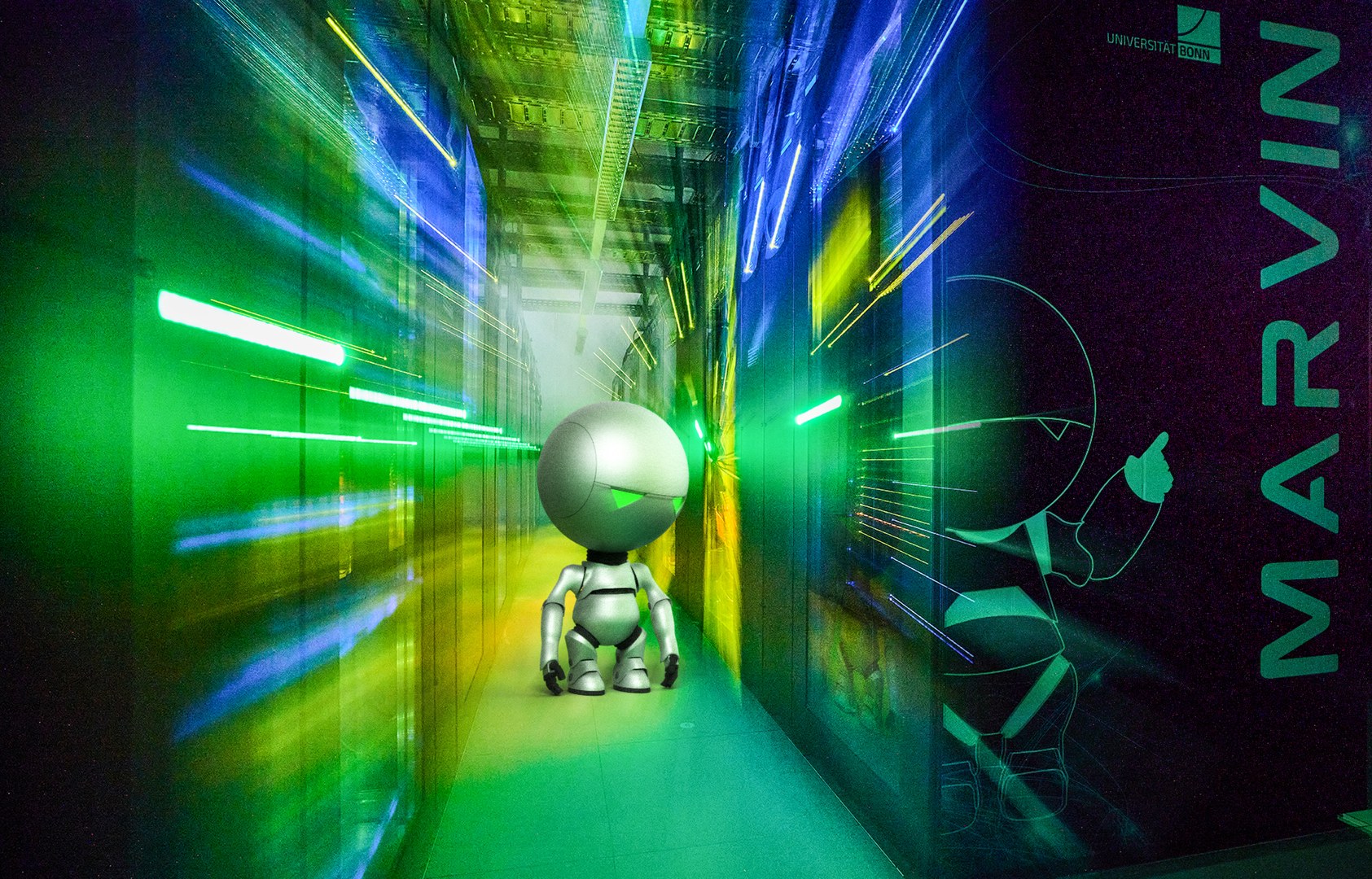Prof. Dr. Maren Bennewitz, Vice Rector for Digitalization and Information Management, explained: “Marvin is not just a computer, but a real game changer for the University of Bonn. It has opened the door to completely new scientific possibilities.” She emphasized the importance of the supercomputer for the strategic orientation of the university in the context of excellence and digitalization. “As part of our excellence and digital strategy, we have made considerable investments in the development of a state-of-the-art HPC research infrastructure. This has been made possible in particular by the newly created structures of the Digital Science Center (DiCe).”
A trophy for the most exciting Marvin project
Seven finalists from different disciplines — from theoretical chemistry to geodesy, linguistics, and biology to astrophysics — presented their extraordinary projects, which could be realized with the help of calculations on Marvin. The approx. 100 guests used their smartphones to vote for their favorite using an app. The interdisciplinary team Nicolas Kluge Correa (philosophy), Aniket Sen (physics), Shiza Fatimah (computer science) and Sophia Falk (environmental sciences) were delighted with the winning trophy. They won the award with their project “Tucano: Advancing Neural Text Generation for Portuguese”. In addition to “extra computing capacity”, the first prize includes close project support from a member of the HPC support team, who offers exactly the support the research team needs — from code testing to software installations or special training.
“We're delighted!” said Nicolas Kluge Correa, explaining: ”Our project is about developing models such as ChatGPT for languages for which there are fewer data sets in direct comparison with English, for example.” He and his team first developed the basics for Portuguese, as he himself is Brazilian and speaks Portuguese. But the group still has big plans: “Next, we are planning this kind of research for other languages spoken by my team members. Aniket speaks Bengali and Shiza Hindi.” He emphasizes that all of this is only possible thanks to Marvin — “and the great support from the University of Bonn”. Katrin Drysch was delighted to take second place with her project “Development of magnesium batteries”, while Mohamad Hakam Shams Eddin and Prof. Dr. Jürgen Gall took third place with their project “Identifying Spatio-Temporal Drivers of Extreme Events”.
Wide range of services for researchers, from technical support to advice
The provision of Marvin is not only about excellent technology, but also about a low-threshold offer for researchers, emphasized Vice Rector Bennewitz. “From the outset, it was also our goal to establish a central HPC infrastructure with corresponding support structures. Under your leadership, dear Dirk Barbi, the HPC team at the Hochschulrechenzentrum (HRZ) has developed into a central unit for operations and training. And with you, dear Petra Mutzel, we have successfully established the High Performance Computing and Analytics Lab at DiCe as an important hub for advising researchers.”
A year full of groundbreaking research results
Prof. Dr. Petra Mutzel and Dr. Dirk Barbi, who were actively supported at the event by Dr. Daniel Minge (TRA Modelling), reviewed the past twelve months. “Marvin has provided our researchers with a toolbox for a wide range of scientific disciplines - from revolutionary simulations in theoretical chemistry to groundbreaking applications of AI for the analysis of historical manuscripts,” explained Prof. Mutzel, who, together with her team, advises researchers on the use of Marvin. Dr. Dirk Barbi, who is responsible for the technology with his team, added: “With Marvin, we have created a stable central infrastructure that enables research at the highest level. We are well equipped — also in the field of artificial intelligence.”
Another highlight of the event was a presentation by Dr. Timothy Mattson, one of the world's leading experts in parallel programming. In his keynote speech “The Hitchhiker's Guide to the Future of HPC — Processors, People and Programming”, he provided exciting insights into the challenges and opportunities of supercomputer research in the coming years. Mattson will continue to engage in a direct exchange with the Bonn scientists in workshops over the coming days. Vice Rector Bennewitz concluded: “Thanks to Marvin, researchers from different disciplines can now work together on complex challenges, master growing amounts of data and develop innovative solutions for the most pressing problems of our time. These resources not only support our research — they also strengthen our position as an internationally competitive university of excellence.”
Marvin supercomputer: facts, figures and data
With a connected load of 430 kW, 14 racks, 320 NVIDIA GPUs and 18,400 CPU cores, Marvin is one of the most powerful academic supercomputers in Germany. Two thirds of its capacity is specially optimized for machine learning and AI applications — a unique selling point in the university environment. Since its commissioning on March 11, 2024, Marvin has already supported 495 registered users from 102 research groups. During this time, 1,022 support requests have been processed and a total of 46 courses have been accompanied. While the HPC team at the HRZ is responsible for the technical operation and support of Marvin, the employees in the High Performance Computing and Analytics Lab (HPC/A-Lab) are the first point of contact and coordinators for the researchers.
A measure in the digital strategy
The University of Bonn's digital strategy defines the measures and structures of its digital transformation. The Marvin project was a measure in the target area of infrastructure for research, teaching, and services.

